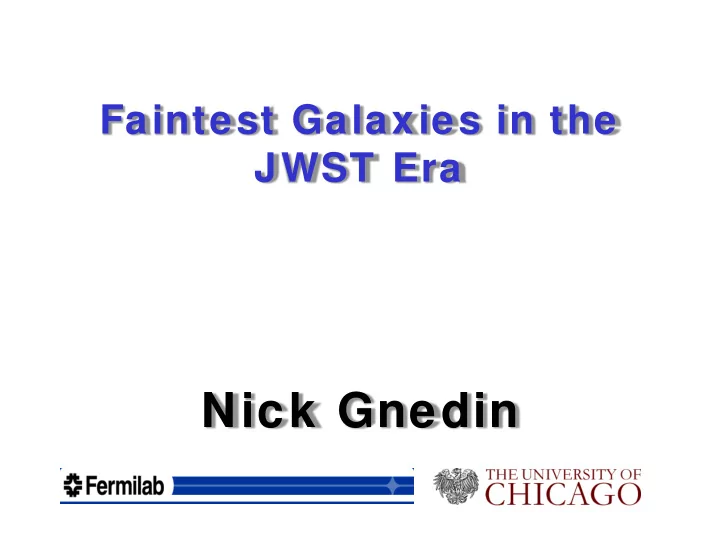

Faintest Galaxies in the JWST Era Nick Gnedin
The Brief History of Time End of inflation: Today: z=10 27 z=0 t=10 -36 s t=13.7 Gyr
The Brief History of Time ionized neutral ionized RE-IONIZATION
What We Know Now : Galaxy Luminosity Functions Data (may) exist all the way to z =10 and M UV =-13. = -2.5 log 10 (L * )+5 10 8 L 10 6 L Livermore+ 2016 Bouwens+2015
What We Know Now : Galaxy Luminosity Functions High redshift galaxies are not particularly glaring. The faintest ones are detected with the help of gravitational lensing in HST Frontier Fields.
The Flood Is Coming: JWST James Webb Space Telescope (JWST) is the primary NASA mission for the next decade. Launch date: 2021? Destination: L2 Mirror: 6 meters
The Flood Is Coming: JWST Studying reionization sources is the primary science goal of JWST. It will perform a range of surveys of varying depth, greatly improving Covered with lensing precision of luminosity functions, as well as studying individual galaxies. -25 -15 -13 Mason+ 2015
The Flood Is Coming Reionization research is on the brink of a major breakthrough(s). Forthcoming observations will make all existing models obsolete. Hence, theorists’ task is not to make more models now, but rather to develop new modeling technology. And it is happening: • DRAGONS • Aurora • Emma • Cosmic Dawn • Renaissance Simulations • CRASH • SPHINX • CROC
The Flood Is Coming One (typical) example in action: Disclaimer: other projects/efforts are achieving similar overall levels of computational scale, agreement with data, etc.
Simulating Reionization: Physics Dark matter Gas dynamics Atomic processes Radiative transfer Star formation & stellar feedback
Simulating Reionization: Physics Star formation & stellar feedback are modeled as a sub-grid recipe . We are not starting from scratch, just using what is shown to work by low-z projects (Illustris, EAGLE, NIHAO, MUFASA, …).
Simulating Reionization: Scales Capturing most of star-forming galaxies requires boxes ~ 50-100 Mpc (comoving). Resolving star formation requires resolution ~100-200 pc (depends on your sub-grid model). Resolving all star-forming galaxies requires mass resolution of about 10 6 M . Conclusion: we need simulations with spatial dynamic range L/ ∆ x ~ 100,000 mass dynamic range M box /M cell ~ 10 billion
Moore’s Law REIONIZATION Doubling in speed every 13 months
Simulating Reionization: CROC on Blue Waters Box size: 120 Mpc Resolution: 100 pc
CROC in Blue Waters
The CROC Project: Convergence Study Mass 10 17 M 10 7 M 10 6 M Space 100 pc 60 Mpc 120 Mpc
The CROC Project: Success Galaxies (and many other things) are ok!
The Role of JWST: There Will Be Blood! All simulation agree with the data where the data exist. They all disagree (for a good reason!) strongly JWST in the regime that JWST will probe. JWST will kill most (or all) existing models.
Take Aw ay Points Models will not die in vain – they differ for physical reasons, encapsulating our ignorance of star formation and stellar feedback. JWST measurements will strongly constraint such models, telling us important information about “sub-grid” processes (for example, whether stars can form in atomic gas). We are entering a golden age of reionization studies, with observations and theory in good balance to ensure rapid progress. Lots of fun ahead…
The End
Recommend
More recommend